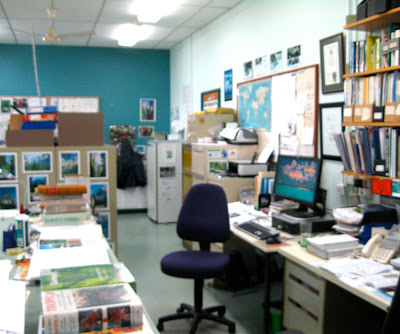Onsite at the Brisbane Botanic Gardens at Mt Coot-tha there are 2 facilities involved in the work of plant identification. The Queensland Herbarium, Biodiversity Sciences is the centre for research and information on the Queensland flora, vegetation and plant communities.It is part of the State Govt's Environment and Management portfolio and as such deals with the concerns of the entire State.
The other facility is the Garden's specific plant identification unit at the Administration Centre where I was pleased to be able to meet with the Senior Botanical Officer Phil Cameron last week. His recently published document 'Plant Census 2010' is the current listing of all species to be found in the Gardens. Establishing the Bio-geographical context of plants is the main work of this unit - with a focus on South East Qld being of primary concern.
Involvement in the International Seed Exchange Program has been a part of the unit's activities over many years. However participation in the Kew Garden's Millennium Seed Bank Project in recent years has stepped up to become quite a focus for this Unit.
This is the data sheet above to be filled out for each specimen being collected.
Phil Cameron explaining the process of researching and cross-referencing to determine the precise origin, name and characteristics of a specimen. An interesting discussion ensued on the role high quality, scientific botanical art can play in aiding this process.
Scanning this interesting room I took in maps, compendiums of various kinds, books, magazines, plant species and containers with piles of data. Not unlike my current art studio in some ways only on a much larger scale and less chaotic by far! Apologies for the poor image of what was actually a most engaging workspace.
Under the microscope - having spent some time in the seed lab where seeds can be miniscule I well understand how useful this equipment must be in this line of work.
These elegant canoe shaped pods were lying on a bench where they caught my eye. One can imagine children being very drawn to these....reminiscent of a time when such found objects would have been automatically utilised.
Thank you to Phil Cameron for kindly taking me through this fascinating facility!







2 comments:
Hey Sophie
I'm impressed, Phil got a hair cut specially for the occasion and its such a comprehensive coverage of the Lab and its function - I'm sure Phil will be very flattered! Do hope all the very worthwhile work going on there is broadly recognised and continues to be widely supported.
Cheers, BP
Thanks for visiting Bettina,
I'd have liked more images of the space where all this activity takes place. One doesn't like to intrude but I'm realising a few more snaps would have added to the story.
There were some excellent books and a wonderful rather grand looking book where entries of species were hand-written...going back quite a long time.
Important work as you say - I saw an article through google today how the Millennium Seedbank had suffered with the financial turmoil in the past year or so. They had costed out the price of each individual seed being collected at 2,000 pounds per seed...what's that in $'s?
No wonder Kew Gardens website is promoting an "adopt a seed" strategy.
Seeing the work Phil and others like him are doing is an eye opener. I look forward to posting more on this over the year!
best,
Sophie
Post a Comment